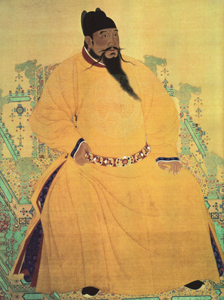Purple Forbidden City

- Ankunft in der Verbotenen Stadt - Malerei der frühen Ming-Zeit. China.
- The Beijing Palace-City Scroll, now held in the National Museum of China, Beijing.
- Painted in the mid-Ming Dynasty (c. 15th century), depicting figures including the chief architects of the Forbidden City.
What's In A Name?
"The English name, 'The Forbidden City,' is a translation of the Chinese name in pinyin Zi Jin Cheng. This literally means 'Purple Forbidden City'. Alternatively another English name with similar origin is 'Forbidden Palace' "
"The name 'Zi Jin Cheng' is a name with significance on many levels. Zi, or 'Purple', refers to the North Star, which in ancient China was called the Zi Wei Star, and in traditional Chinese astrology was the abode of the Celestial Emperor. The surrounding celestial region, the Zi Wei Enclosure (Pinyin: Zi Wei yuán), was the realm of the Celestial Emperor and his family. The Forbidden City, as the residence of the terrestrial emperor, was its earthly counterpart. Jin, or 'Forbidden', referred to the fact that no-one could enter or leave the palace without the emperor's permission. Cheng means a walled city".
"Present day, the site is more commonly known in Chinese as Gù gong, which means the 'Former Palace.' The museum which was built and run here in these buildings is known as the 'Palace Museum' (Pinyin: Gù Gong Bó Wù Yùan)".
History of the Forbidden
"The site of the Forbidden City was situated on the Imperial City during the Mongol Yuan Dynasty. Upon the establishment of the Ming Dynasty, the Hong wu Emperor moved the capital from Beijing in the north to Nan jing in the south, and ordered that the Yuan palaces be burnt down. When his son Zhu Di became the Yong Le Emperor, he moved the capital back to Beijing, and construction began in 1406 of what would become the Forbidden City".
"Construction lasted 15 years, and required more than a million workers. Material used include whole logs of precious Phoebe zhennan wood (Pinyin: nán mù) found in the jungles of south-western China, and large blocks of marble from quarries near Beijing. The floors of major halls were paved with 'golden bricks' (Pinyin: jin zhuan), specially baked paving bricks from Su Zhou".
1420-1900
"From 1420 to 1644, the Forbidden City was the seat of the Ming Dynasty. In April 1644, it was captured by rebel forces led by Li Zi cheng, who proclaimed himself emperor of the Shun Dynasty. He soon fled before the combined armies of former Ming general Wu San gui and Manchu forces, setting fire to parts of the Forbidden City in the process. By October, the Manchus had achieved supremacy in northern China, and a ceremony was held at the Forbidden City to proclaim the young Shun Zhi Emperor as ruler of all China under the Qing Dynasty. The Qing rulers changed the names of the principal buildings, to emphasise 'Harmony' rather than 'Supremacy', made the name plates bilingual (Chinese and Manchu), and introduced Shamanist elements to the palace".
"In 1860, during the Second Opium War, Anglo-French forces took control of the Forbidden City and occupied it until the end of the war. In 1900 Empress Cí xi Tài hòu fled from the Forbidden City during the Boxer Rebellion, leaving it to be occupied by forces of the treaty powers until the following year".

- Source: Ann Paludan
- Source location: Chronicle of the Chinese Emperors.
- Source Place and Year: Thames and Hudson, London 1998.
Preservation
"After being the home of 24 emperors—fourteen of the Ming Dynasty and ten of the Qing Dynasty—the Forbidden City ceased being the political centre of China in 1912 with the abdication of Pu Yi, the last Emperor of China. Under an agreement with the new Republic of China government, Pu Yi remained in the Inner Court, while the Outer Court was given over to public use, until he was evicted after a coup in 1924. The Palace Museum was then established in the Forbidden City. In 1933, the Japanese invasion of China forced the evacuation of the national treasures in the Forbidden City. Part of the collection was returned at the end of World War II, but the other part was evacuated to Taiwan in 1947 under orders by Chiang Kai-shek, whose Kuomintang was losing the Chinese Civil War. This relatively small but high quality collection was kept in storage until 1965, when it again became public, as the core of the National Palace Museum in Taipei."
Recent Times
"After the establishment of the People's Republic of China in 1949, some damage was done to the Forbidden City as the country was swept up in revolutionary zeal. During the Cultural Revolution, however, further destruction was prevented when Premier Zhou En lai sent an army battalion to guard the city."
"The Forbidden City was declared a World Heritage Site in 1987 by UNESCO as the 'Imperial Palace of the Ming and Qing Dynasties', due to its significant place in the development of Chinese architecture and culture. It is currently administered by the Palace Museum, which is currently carrying out a sixteen-year restoration project to repair and restore all buildings in the Forbidden City to their pre-1912 state."
Source: Wikipedia